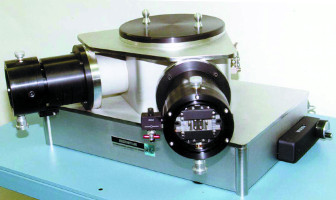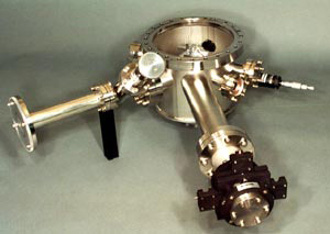
Seya-Namioka Vacuum Monochromator
The 235 is the McPherson 500 mm focal length Seya-Namioka monochromator. This optical system is housed in a clean stainless steel housing capable of achieving 10-6 torr vacuum. It delivers typical resolution of 0.05 nm with a 1200g/mm grating. An angle of 70° 15' subtends the entrance and exit slit arms. Seya-Namioka mounting maintains all components (slits and gratings) on the Rowland circle. Resolution is maintained over a broad spectral region, astigmatism should be considered depending on the application. The focal length provides increased resolution and work space. Stainless steel construction makes this proven design suitable for use with high vacuum, contaminant free experiments or microchannel plate intensifiers. Wavelengths from 30-nm to 1.2-um can be covered within the scanning range and with appropriate gratings. The 235 is for scanning and microchannel plate intensifier or CCD spectroscopy.
| Optical Design | Seya-Namioka |
| Angle of Incidence | 35.125 degrees |
| Focal Length | 500 mm |
| f/no. | 11.6 |
| Wavelength Range | refer to grating of interest for range |
| Wavelength Accuracy | +/- 0.10 nm (with 1200 g/mm grating) |
| Wavelength Reproducibility | +/- 0.005 nm (with 1200 g/mm grating) |
| Grating Size | 30 x 50 mm (single kinematic grating holder) |
| Slits | Continuously variable micrometer actuated width 0.01 to 2 mm. Settable height. |
| Vacuum | High vacuum 10E-6 torr |
| Focal Plane | 25 mm microchannel plate or direct detection CCD |
| Grating Groove Density (g/mm) | 2400 | 1200 | 600 | 300 |
| Spectral Resolution (nm,FWHM) | 0.025 | 0.05 | 0.1 | 0.2 |
| Dispersion (nm/mm) | 0.83 | 1.6 | 3.3 | 6.6 |
| Wavelength Range ~30nm up to (nm) | 150 | 300 | 600 | 1200 |
| Blaze Wavelength: (nm) | holo | 70 | 150 | 550 |
| 150 | ||||
| 200 |
* gratings work best from 2/3 to 3/2 the blaze wavelength



The Seya-Namioka is ideal when experiments require more work space around the slits. The large included angle insures that exit or entrance-slits can 'reach' into source chambers or be postioned close by a sample. The Seya also holds up with direct detection array detectors or microchannel plates. For scanning monochromator or spectrograph detection applications the Model 235 delivers a good compromise of instrument size and spectral performance.
Call to discuss the deatils of your application today.